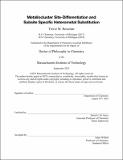| dc.description.abstract | The deployment of metalloclusters in applications such as catalysis and materials synthesis requires robust methods for site-differentiation: the conversion of clusters with symmetric ligand spheres to those with unsymmetrical ligand spheres. However, imparting precise patterns of site-differentiation is challenging because, compared with mononuclear complexes, the ligands bound to clusters exert limited spatial and electronic influence on one another. In Chapter 2, we described a method that used sterically encumbering ligands to bind to only a subset of a cluster’s coordination sites. Specifically, we showed that homoleptic, phosphine-ligated Fe–S clusters undergo ligand substitution with N-heterocyclic carbenes to give heteroleptic clusters in which the resultant clusters’ site-differentiation patterns are encoded by the steric profile of the incoming N-heterocyclic carbene. This method afforded access to every site-differentiation pattern for cuboidal [Fe₄S₄] clusters and was extended to other cluster types in Chapter 3, particularly in the stereoselective synthesis of site-differentiated Chevrel-type [Fe₆S₈] clusters. In Chapter 4, we further utilized the 3:1 site-differentiation of cuboidal [M₄S₄] (M = Fe or Co) clusters to perform subsite specific metal atom substitution at each cluster. Specifically, we showed that the unique metal sites of homometallic clusters of the form [M₄S₄(IMes)₃Cl]+ can be selectively excised by addition of 2 equiv TlTp. Reconstitution with M′Cl2 (M′ = Co, Fe, for M = Fe, Co, respectively) yielded the heterometallic clusters [CoFe₃S₄(IMes)₃Cl]+ and [FeCo₃S₄(IMes)₃Cl]+. The reduced clusters, [M′M₃S₄(IMes)₃Cl], as well as the CO-bound clusters, [M′M₃S₄(IMes)₃(CO)], were also prepared, and a comparative analysis of the properties of all three series of clusters was undertaken. Low-valent electronic configurations are accessed in all four clusters, [Fe₄S₄(IMes)₃(CO)], [CoFe₃S₄(IMes)₃(CO)], [Co₄S₄(IMes)₃(CO)], and [FeCo₃S₄(IMes)₃(CO)], and this studied further reveals how heterometal substitution modulates the degree of C–O bond weakening. | |
